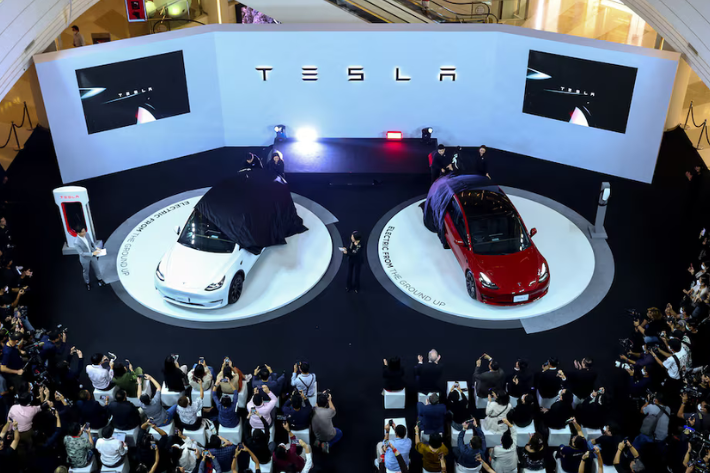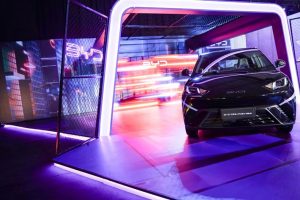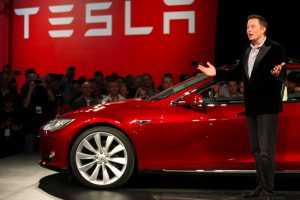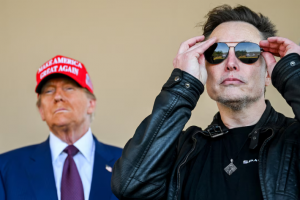US auto giant Tesla looks set to push for a bigger pie of Southeast Asia’s booming electric vehicle (EV) market even as it faces tough competition from key rival BYD and other Chinese carmakers.
This week, Tesla delivered its first set of Model Y cars in Malaysia, after the Anwar Ibrahim government gave it the licence last year to sell its cars in the country.
The company also sells its Model 3 compact sedan in Malaysia and even plans to establish a network of charging stations there.
Also on AF: Nissan, Honda Seen Slashing China Production By Up To 30%
“As a Malaysian, the wait for Tesla to come in has been excruciatingly long,” one Model Y buyer posted on X.
Responding to the post, a senior Tesla executive called Southeast Asia “a major place of growth over the coming years in battery storage and electric vehicle adoption.”
Huge congrats @1stPrincipleInv, and thank you for your support! Malaysians are going to really love the Model Y, and our @Tesla_Malaysia team is motivated to create the best ownership experience possible.
Southeast Asia will undoubtedly be a major place of growth over the… https://t.co/sSnnKy5amI
— Rohan Patel (@rohanspatel) March 12, 2024
Indeed, Southeast Asia has emerged as one of the hottest EV markets in recent years and could offer Tesla a large customer base at a time when demand is slowing in its two biggest markets: China and the United States.
A key reason for the region’s growing prominence for EV-makers is that it has, for long, remained a laggard in electric vehicle adoption. EV sales were just 2.1% of total vehicle sales in Southeast Asia in 2022.
But by the second-quarter of 2023, the region became the “hottest major EV market globally”, with sales in the region growing 894% during the period, according to Counterpoint Research.
And by the third-quarter, EVs constituted 6.4% of all passenger vehicle sales in the region.
Indonesia, Thailand and Malaysia are the largest auto markets in Southeast Asia. Counterpoint included those markets plus Vietnam, Philippines, Singapore and Myanmar in its analysis of EV sales in the region.
Climate concerns driving EV shift
Key factors holding back EV adoption in Southeast Asia included a dearth of charging infrastructure outside urban centres, a lack of tax incentives and subsidies for both automakers and buyers, and slow progress on developing affordable EVs, analysts said.
But in a recent report, consulting firm EY noted that “societal concerns over climate change are now driving a rapid shift in policies and consumer attitudes toward EVs,” in the region.
The report added that EV growth has also been furthered by “financial incentives to improve the affordability of EVs” in Southeast Asian markets.
In its latest budget, for instance, Malaysia introduced a variety of tax incentives for EV producers, buyers and even rentals. That was in addition to tax exemptions that were already in place since 2022.
Countries like Thailand and Indonesia have similar incentives in place too.
The China challenge
Tesla is also in talks for expanding its operations in other countries, including in Thailand, which is Southeast Asia’s largest car producer and exporter. By 2030, Thailand aims to convert around 30% of its annual production of 2.5 million vehicles into EVs.
A Thai government official said earlier this month that the company had discussed a potential production facility after surveying a site late last year.
Still, Tesla’s ambitions for Southeast Asia will have to contend with competition from Chinese rivals who sold three out of every four EVs in the region in first quarter of 2023.
Its biggest rival will be BYD — which has already overtaken Tesla in terms of global sales. The Chinese carmaker has also shot past its competitors to account for more than a quarter of the EVs sold in Southeast Asia.
In contrast with Tesla’s direct-to-consumer approach, BYD has partnered with large, local conglomerates that have allowed the carmaker to expand reach, test consumer preferences and navigate complex government regulations in the region.
The Chinese EV maker sold more than 26% of all cars in Southeast Asia in the second quarter of 2023, while Tesla accounted for about 8%, according to Counterpoint.
- Reuters, with additional inputs from Vishakha Saxena
Also read:
Apple, Tesla See China Sales Plunge as Local Rivals Catch Up
Smaller Profit Margins Help China’s BYD Steal Tesla’s EV Crown
Tesla-BYD Lock Horns in China With Deep Discounts, Incentives
Indian Carmakers Block EV Import Tax Cut to Prevent Tesla Entry
China EV Firms Can Destroy Rivals Without Trade Barriers: Musk
EU Says China EVs Funded by Subsidies, Plans Retroactive Tariffs
Biden Orders Probe Into Data Security Risks From Chinese EVs
























